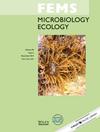光比机械更重要:模拟迁移床层中的微生物群落结构和活动受振荡光而非机械力控制
IF 3.5
3区 生物学
Q2 MICROBIOLOGY
引用次数: 0
摘要
低地溪流的沙质沉积物是以洄游涟漪的形式迁移的。在沙粒上定植的底栖微生物暴露在频繁的移动-静止循环中,并被认为受到两个主要环境因素的影响:移动阶段造成生物膜磨损的机械应力和静止阶段的光暗交替循环。我们的研究包括两个实验室实验,目的是破译是哪种环境因素导致了之前观察到的波纹迁移过程中与沉积物相关的微生物活动受阻和群落结构改变。第一个实验测试了在可比光照条件下三种不同迁移速度的影响。第二个实验比较了恒定光照或光照振荡条件下的迁移沉积物和静止沉积物。我们假设微生物活动和群落结构会受到以下因素的影响:1)较高的迁移速度比较低的迁移速度更强;2)光振荡比机械应力更强。综合这两项实验的结果,我们观察到暴露在光振荡条件下的沉积物微生物活性较低,群落结构发生了改变,而迁移速度对群落活性和结构的影响较小。我们的研究结果表明,光振荡是波纹迁移过程中起作用的主要环境因素,导致依赖光的光自养生物更加脆弱,并可能转向异养。本文章由计算机程序翻译,如有差异,请以英文原文为准。
Light over mechanics: Microbial community structure and activity in simulated migrating bedforms are controlled by oscillating light rather than by mechanical forces
Sandy sediments of lowland streams are transported as migrating ripples. Benthic microorganisms colonizing sandy grains are exposed to frequent moving-resting cycles and are believed to be shaped by two dominant environmental factors: mechanical stress during the moving phase causing biofilm abrasion, and alternating light-dark cycles during the resting phase. Our study consisted of two laboratory experiments and aimed to decipher which environmental factor causes the previously observed hampered sediment associated microbial activity and altered community structure during ripple migration. The first experiment tested the effect of three different migration velocities under comparable light conditions. The second experiment compared migrating and stationary sediments under either constant light exposure or light oscillation. We hypothesized that microbial activity and community structure would be more strongly affected by 1) higher compared to lower migration velocities, and by 2) light oscillation compared to mechanical stress. Combining the results from both experiments, we observed lower microbial activity and an altered community structure in sediments exposed to light oscillation, whereas migration velocity had less impact on community activity and structure. Our findings indicate that light oscillation is the predominating environmental factor acting during ripple migration, resulting in an increased vulnerability of light-dependent photoautotrophs and a possible shift towards heterotrophy.
求助全文
通过发布文献求助,成功后即可免费获取论文全文。
去求助
来源期刊

FEMS microbiology ecology
生物-微生物学
CiteScore
7.50
自引率
2.40%
发文量
132
审稿时长
3 months
期刊介绍:
FEMS Microbiology Ecology aims to ensure efficient publication of high-quality papers that are original and provide a significant contribution to the understanding of microbial ecology. The journal contains Research Articles and MiniReviews on fundamental aspects of the ecology of microorganisms in natural soil, aquatic and atmospheric habitats, including extreme environments, and in artificial or managed environments. Research papers on pure cultures and in the areas of plant pathology and medical, food or veterinary microbiology will be published where they provide valuable generic information on microbial ecology. Papers can deal with culturable and non-culturable forms of any type of microorganism: bacteria, archaea, filamentous fungi, yeasts, protozoa, cyanobacteria, algae or viruses. In addition, the journal will publish Perspectives, Current Opinion and Controversy Articles, Commentaries and Letters to the Editor on topical issues in microbial ecology.
- Application of ecological theory to microbial ecology
- Interactions and signalling between microorganisms and with plants and animals
- Interactions between microorganisms and their physicochemical enviornment
- Microbial aspects of biogeochemical cycles and processes
- Microbial community ecology
- Phylogenetic and functional diversity of microbial communities
- Evolutionary biology of microorganisms
 求助内容:
求助内容: 应助结果提醒方式:
应助结果提醒方式:


